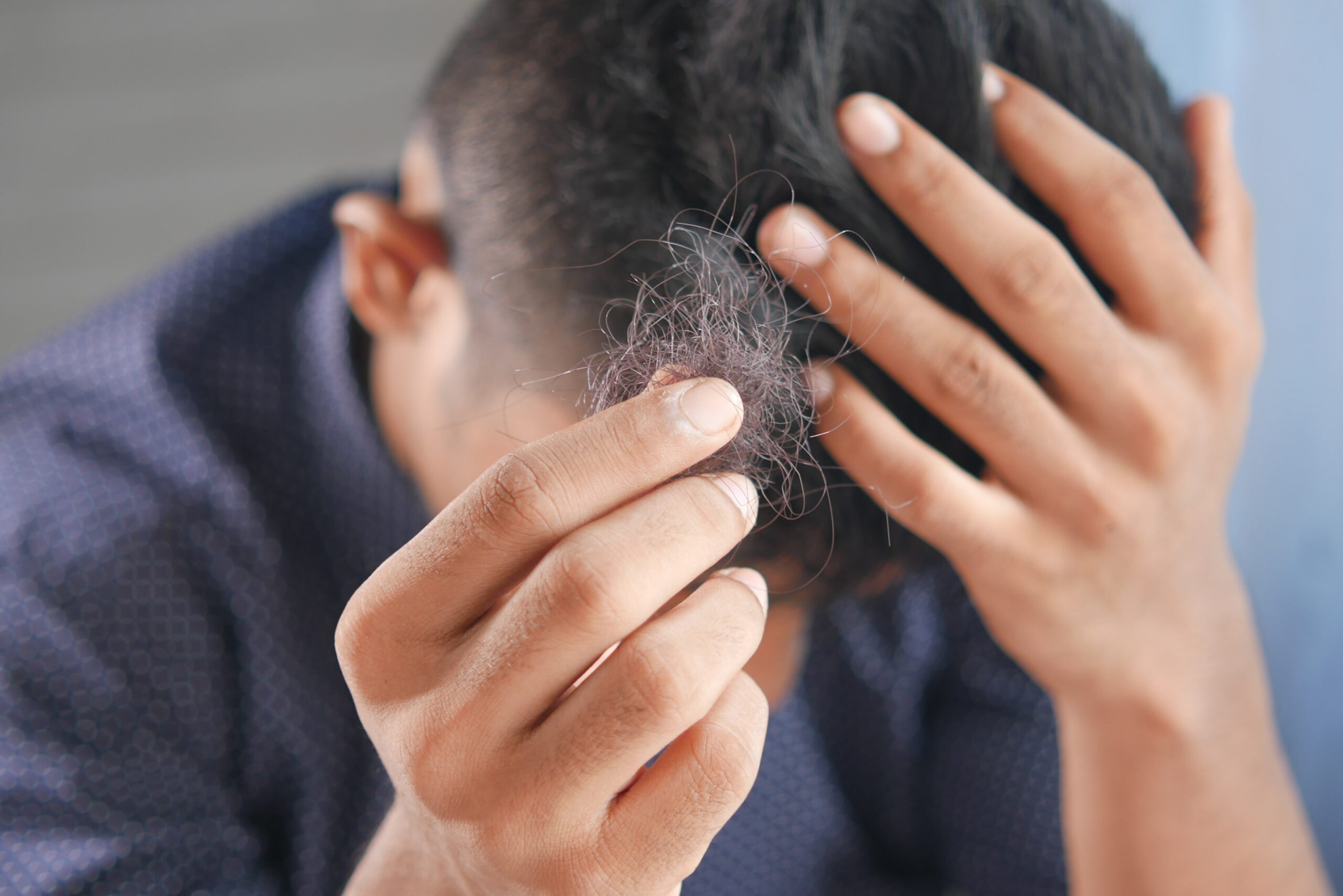
85% of men experience significant hair loss by their 50s, and 20% of men have visible hair thinning by the time they’re just 20 years old.
It’s not uncommon for men to lose hair, whether receding hair, thinning hair or bald patches. Even though it’s normal, it can sometimes be distressing to the person experiencing hair loss, particularly at a young age, affecting self-esteem or pointing to a more serious internal problem.
The following article explains the causes of hair loss, symptoms so you can catch it early and treatments depending on the cause.
Causes of Hair Loss in Men
There are many different causes of hair loss in men, and it’s essential to identify the correct one so you can find the right treatment. Here are the most common causes of hair loss in men.
Age
Unfortunately, age plays a significant factor in hair loss. The body’s ability to regenerate cells naturally slows down and affects the hair follicle. Hair follicles are essentially the pore from which hair strands grow. Age can shrink, mutate, or make the follicle less efficient.
How to treat hair loss from ageing
There is no way to recover hair follicles that have already died from age. However, you can prevent the hair you still have with other treatments. A scientific study introduces new and exciting research that shows when mice were treated to stimulate extra Col17A1 protein, it significantly reduced hair loss. You do the same by introducing collagen-rich foods, the building blocks for creating protein.
Once starting this treatment, you can combine the hair you have already lost with other hair treatments (more on that below).
Alopecia Areata
Alopecia areata is an immune disease when the immune system in your body attacks the hair follicles. It is most likely to affect hair loss on your head and face (such as your beard and eyebrows).
You are at higher risk of developing alopecia areata if it runs in your family or you already have an auto-immune disease. It affects men and women equally and typically appears from teens-thirties.
How to treat hair loss from alopecia areata
There is currently no cure for alopecia areata. However, like most conditions, there is an effective way to manage them. The most common are corticosteroids, an anti-inflammatory drug that soothes the immune system by reducing inflammation. You can get take corticosteroids orally, via injection or using an ointment. You may see an improvement in as little as 4-weeks, but it is a treatment you will need to repeat to manage the condition.
Androgenic Alopecia

Androgenic alopecia (also known as male pattern baldness) is the most common cause of hair loss, affecting almost 50% of men in their lifetime. Your hair has a growth cycle (anagen, catagen, telogen, and exogen). During the telogen phase, the follicle rests and essentially becomes dormant. That means no hair grows, but none is shed. The cycle then moves into the exogen or hair-shedding phase. Androgenic alopecia is when more and more hair follicles stay in the dormant phase, and then the dormant follicles are shed. They do not cycle back to the growth phase, resulting in hair loss.
How to treat hair loss from androgenic alopecia
There is no cure for male pattern baldness, but you can slow it down and possibly increase hair growth. Minoxidil (Rogaine) is a medically verified hair growth treatment commonly used for all types of hair loss.
A 2004 study shows that 5% minoxidil foam increases hair growth in androgenetic alopecia in just 16 weeks, making it an effective treatment. It can cause itching and dryness in the scalp, so using it with hydrating scalp treatments may be beneficial if you opt for minoxidil.
Chemotherapy
Chemotherapy is a treatment for cancer and essentially poisons and kills the cancerous cells. Although it is an effective treatment, it makes the patient very ill, and it’s common to lose hair.
How to treat hair loss from chemotherapy
Your hair should grow back once you complete the course of chemotherapy, although it may take a while. You can do things to improve your hair growth, such as using minoxidil, eating a healthy, anti-inflammatory diet, getting your body moving, and using gentle products on the hair and scalp. You can also access wigs to wear when experiencing baldness and while waiting for the hair to regrow.
Severe Stress or Shock
Prolonged and intense stress increases the release of the hormone cortisol, putting your nervous system into a fight, flight, freeze, or flop mode. When you have excessive amounts of cortisol in your body, it redirects blood, and therefore oxygen and nutrients, away from your hair and to your vital organs. It gives you energy in the critical places of your body if you suddenly need to flee or fight any danger.
Shock also causes hair loss, but for different reasons. It forces the hair growth cycle out of the growing phase and into the resting and shedding phases. 70% of hair falls out around 2-months after the initial shock.
Stress and shock often come hand-in-hand and are characterised by large clumps of hair falling out when you brush your hair or shower.
How to treat hair loss from stress or shock
The main thing you can do is get yourself out of the stressful situation if possible. That may be switching jobs, taking a holiday, or getting additional support. However, that is sometimes easier said than done. Therefore, managing stress through meditation, exercise, and a cortisol-reducing diet will help. When it comes to shock, you often must wait for it to pass. However, the hair follicles won’t be permanently damaged and should grow back.
Trichotillomania
Trichotillomania, or impulse control disorder, is a psychological condition when people get a strong, irresistible urge to pull out their hair. It can lead to specific bald patches on the head, eyebrows and beard and has similar features to Obsessive Compulsive Disorder (OCD).
How to treat hair loss from trichotillomania
Trichotillomania is a mental health condition. Therapy, cognitive behavioural therapy (CBT), and managing stress are ways to reduce and treat trichotillomania. If the root cause of trichotillomania is treated, the hair will return. However, obsessively pulling out hair can damage the follicle over time, leading to thinner patches on the head. These areas can be treated in combination with other hair loss treatments.
Hair Styling and Products

Chemical treatments, such as perming, dying your hair, using heat tools such as straighteners or a hair dryer on high heat and brushing too aggressively will cause hair loss. This is because these practices tug at the root or snap strands of hair.
Some hair products, such as gels and shampoos, can contain harmful and drying ingredients, such as harsh fragrances and preservatives and may trigger hair loss.
How to treat hair loss from styling and products
Handle your hair with care, and don’t brush it vigorously or when it’s wet unless you have curly hair. Avoid harsh hair care ingredients and opt for gentle products on your scalp.
Vitamin Deficiency
Severe vitamin deficiencies can cause hair loss as the body physically does not have the nutrients to grow your hair. It’s a common symptom of a lack of vitamin B12, biotin, and vitamin D.
How to treat hair loss from vitamin deficiency
You can regrow hair loss from vitamin deficiency by eating vitamin-rich foods (this is the most effective treatment). You can also take additional supplements to boost hair regrowth or if your body struggles to produce or absorb a specific vitamin. Check out our vitamin blood test to find out more.
Overall Ways to Treat Hair Loss

- Hair transplant – Hair transplants have come a long way, and they work by transferring active hair follicles from one area of the head to sections of hair loss.
- Laser treatment – Low-level light therapy may work to manage hair loss in alopecia areata or from stress and external damage. Blue light, red light, and near-infrared light therapy are effective.
- Minoxidil – An over-the-counter treatment to encourage hair growth.
- Using gentle products and styling – Replace harsh hair products with scalp and hair-friendly ones, and don’t use damaging styling methods.
- Reducing stress levels – Manage stress to lower cortisol and allow oxygen and nutrients to reach the hair follicle.
- Corticosteroids – Steroids to suppress the autoimmune condition of alopecia areata.
- Supplements and diet – Increase hair regrowth by eating anti-inflammatory and nutrient-dense foods. You can supplement with vitamins you may be deficient in and find out what your body needs using our advanced vitamin blood test.
Reduce Hair Loss in Men

Hair loss in men can be reduced depending on the cause and by using different treatments. Speak to your doctor if unsure of the cause and use these suggestions as effective hair loss treatments.
If You Found This Article Useful, You May Also Like:
- 10 Foods to Lower Your Cholesterol Today
- How to Lower Your Risk of High Cholesterol
- Soak up Vitamin D
Written by Emma Carey.Emma is a health and wellness enthusiast who likes to know the science behind how supplements, vitamins, nutrition and exercise affect the body. She’s on a health and fitness journey to improve her lifestyle and live life to its fullest.

